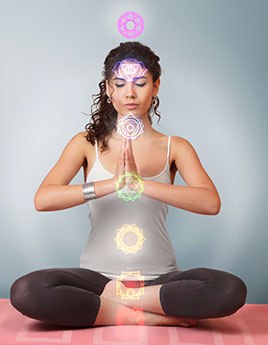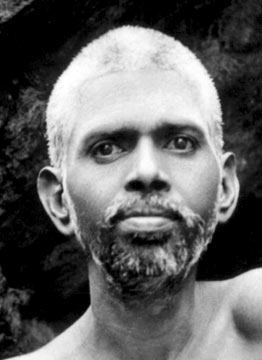
Berit Ellingsen is a long term member of the HS community and was the Editor-In-Chief for Volume III of the HS E-Zine. She worked with great patience and creativity to bring the best out of every article that she edited and often added beautiful graphics to enhance each author’s contribution. Berit lives in Norway. She has a degree in biology from the University of Bergen, Norway. This particular article by Berit Ellingsen appeared in Volume I of the HS E-Zine in the Winter of 2001.
Self-Realization in Jnana, Kundalini, and Tantra Yogas
Kundalini Yoga
Kundalini-Shakti, in traditional Indian spiritual sources, is described as the energy that propels man to liberation. Thus, awakening this energy in the body(mind) of the practitioner is central in some liberation teachings, most notably, the Kundalini Yoga systems and the Tantra Yoga systems. As the energy moves in the central channel in the body from its resting place and source in the Muladhara Chakra to the Sahasrara Chakra, and enlivens the passive element of the mind, liberation is said to ensue.
Jnana Yoga
Jnana Yoga, the “yoga of knowledge”, the type of yoga most commonly associated with Advaita Vedanta and the non-dual perspective, does not have the body and its energies as the main focal point for spiritual development, but the mind itself. Jnana Yoga uses the individual consciousness as a tool to learn about the true self and thus attain liberation.
One method of Jnana Yoga is Sri Ramana Maharshi’s method of self inquiry, atma-vichara. In asking oneself “who am I ?” one centers the individual consciousness onto its source. Thus, by focusing the conscious mind on the still point, the witness, to witness the very act of witnessing, the barrier between the perceiver and the perceived vanishes.
Awakening the power of Kundalini-Shakti alone and manipulating this energy is not seen as a prerequisite for attaining liberation, and Kundalini-Shakti does not have a central place in the texts of Jnana Yoga. The method of atma vichara alone is enough to bring about liberation (“Be As You Are, The Teachings of Sri Ramana Maharshi”, edited by D. Godman, p. 142 and p. 146).
Is there nevertheless common ground between Jnana Yoga and Kundalini Yoga ?
From a non-dual perspective, Kundalini-Shakti is but one form of the Self. Kundalini-Shakti is the Self, pure energy and pure Being (Be As You Are, The Teachings of Sri Ramana Maharshi, edited by D. Godman, p. 145). The human mind with its consciousness is also a form of energy, of consciousness and Self.
Kundalini and Tantra Yoga
In Kundalini Yoga and Tantra Yoga, Kundalini-Shakti can be influenced by other energies such as sound (mantra), light and darkness combined into symbols (yantra and mandala) and movements of the physical body (asanas). In Kundalini Yoga, concentration on these energies and on various psychoenergetic centers, the chakras, is said to bring the Kundalini energy to these centers to break through the seven veils (chakras) that stand between union of the individual soul, Atman, with Shiva (or the non-dual consciousness, the Self).
To become strong enough to break through the seven veils of consciousness and reach the Sahasrara Chakra, the Kundalini energy must purify the body and mind in a process which may take many years. In this process, the energy will not always stay in the central channel, but spread out from the Muladhara Chakra in a broad fan that may include the entire lower body or torso in a process that can be complex.
The common denominators in manipulating the Kundalini-Shakti to attain liberation are concentration and focus. Where the mind and individual consciousness, the individual thought energy, is moved and focused on, there Kundalini-Shakti in the individual mind-body also moves. Thus, it makes sense to move consciousness not only onto energy centers, chakras, in the individual body, but instead directly onto and into its own source.
During the practice of atma-vichara, where the consciousness turns inward onto its own source, not to repress any thoughts or concentrate on any subject apart from the act of witnessing itself, the Kundalini-Shakti will automatically become concentrated into a fine beam. It will easily be led back to its source by rising upwards in the central channel with a force strong enough to break through the one true veil between man and liberation, the very idea that the individual consciousness is separate from the Self. The energy of consciousness, the Kundalini-Shakti, in this way is used as a laser beam to melt a single window instead of as a ram to bring down seven gates. No conscious piercing of the Sahasrara or any other Chakra on behalf of the individual mind is needed.
Full Liberation
To bring about full liberation, Sri Ramana Maharshi recommended to continue to clean out the vasanas (the contents of the body-mind which keeps the Atman identified with the body-mind) which may be present even after the identification with sat-chit-ananda has been experienced in the first Nirvikalpa Samadhi (“Be As You Are, The Teachings of Sri Ramana Maharshi”, edited by D. Godman, p. 66-67). After the first Nirvikalpa Samadhi, Kundalini-Shakti may manifest spontaneously, or where already present, the energy may increase the strength and efficiency of its manifestation. The Kundalini energy will then bring more of the vasanas (latent tendencies) to the attention of the conscious mind.
As a result of the knowledge experienced in Nirvikalpa Samadhi, the mind will ask itself “to whom did these events happen ?” and the true nature of this mind content is seen and disidentified with. In this process, the Kundalini energy brings the vasanas to the conscious mind where they eventually evaporate like water in sunlight.
Thus, Jnana Yoga and Kundalini Yoga may share common ground in the effect of the Kundalini-Shakti in the body-mind, both prior to the first Nirvikalpa Samadhi as well as afterwards. The difference between the two yoga systems lies primarily in the view of how this energy should be employed, either directly, as in Kundalini and Tantra Yoga, or indirectly, as in Jnana Yoga.







You must be logged in to post a comment.